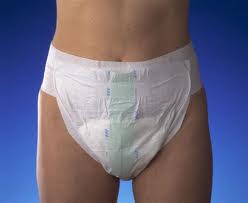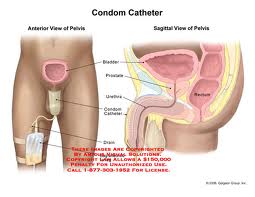Many products are available to help manage urinary incontinence, including incontinence pads, incontinence briefs, and condom catheters. In addition, techniques such as bladder training may be used to help a person overcome certain types of incontinence. For
some people, temporary or permanent catheterization may be necessary to manage the incontinence.
Incontinence Pads and Briefs


Products made for urinary incontinence are available to help prevent soiling of clothes and furniture. Incontinence pads and briefs are specially made to absorb urine and hold it away from the person’s skin. Keeping the skin dry helps to reduce the skin problems that can occur from prolonged contact with urine. Incontinence pads are placed inside the person’s underpants to prevent wetting of the clothes and to draw the moisture away from the person’s body. Incontinence briefs are worn instead of underpants.
Incontinence pads and briefs are very useful foractive people. For a person who is confined to bed, special bed protectors are used to help to keep the bed linens and mattress dry and to wick urine away from the person’sskin. Many facilities have policies that specify that incontinence briefs are to be used only when the person is out of bed, and that bed protectors are to be used when the person is sleeping. Incontinence briefs tend to fit closely, which makes it difficult for air to reach the skin. Switching between briefs and bed protectors helps to prevent skin breakdown by allowing the skin to be exposed to the air at night. As a nursing assistant, you must make sure that these incontinence products are changed frequently and that urine is cleaned from the skin whenever the change occurs.
Condom Catheters


A condom catheter can be used to manage incontinence in men. A condom catheter is not a true catheter because it is not placed inside the body. It consists of a soft plastic or rubber sheath, tubing, and a collection bag for the urine. The sheath is placed over the penis and the collection bag is attached to the leg. The urine flows through the tubing into the collection bag, allowing the man to urinate at will. The condom must fit the penis. It should be fastened securely enough to prevent leaking, but not so snugly that it restricts circulation. Many condom catheters have adhesive material on the inside of the condom that allows for a good seal. Others must be secured with elastic tape. The tape strip is applied in a spiral fashion to allow for changes in the size of the penis. Applying the tape in an overlapping, circular fashion would compromise blood flow if the man had an erection, possibly causing permanent
damage to the penis. Use of a condom catheter requires good skin care. The penis must be cleaned, and the condom apparatus changed, daily.
Bladder Training
Bladder training is commonly used to help people relearn how to control their urinary elimination. For example, a person may be encouraged to use the bedpan, urinal, or commode at scheduled times. Scheduling helps promote regular emptying of the bladder.
The primary goal is for the person to be able to control involuntary urination. If this is not possible, then the person may still at least be able to get to the bathroom in time to avoid accidents, because she will know when voiding is due to occur. The person’s care plan will note any special bladder training techniques that are being used and the nurse will instruct you on any specific duties you will be assigned as part of that training.